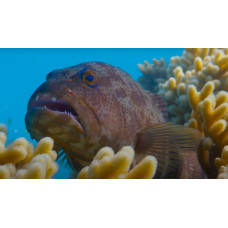Serranidae is a family of fishes of the order Perciformes. Anal fin with three barbed rays. Dorsal fin is usually single, with a well-defined barbed part. Pelvic fins on the chest. Predominantly marine, rarely freshwater (Chinese perch - Aucha perch) inhabitants of tropical and subtropical waters of the Atlantic, Indian and Pacific Oceans. The name "rock bass" is associated with the fish's inhabitation in the coastal zone among stones, rocks, corals. All are predators. Many hermaphrodites. Length up to 3.6 m and a mass of 350 kg (small-eyed grouper). About 100 genera (laurels, rock, Chinese perch, groupers, etc.), more than 400 species. Serranidae are important objects of fishery.
In general, rock bass have a massive body, large mouth, gill covers covered with spines. One dorsal fin with a well-developed barbed part, sometimes it is a separate fin. In the anal fin, which is shorter than the soft part of the dorsal fin, 3 barbs. In the pelvic fins, located on the chest, 1 barb and 5 soft rays. Small sharp teeth are lined up in several rows, in some species in the front part of the upper and lower jaw protruding fangs. Coloration is bright, characteristic of reef fish. All rock bass are predators, mainly hunting from ambush. Cannibalism is common. These fish are fished with hooked fishing gear, hit with spears.
The family comprises about 75 genera and more than 400 species of mainly marine fishes inhabiting the subtropical and tropical regions of the Atlantic, Pacific and Indian Oceans. Some Serranidae (Chinese perch) inhabit fresh waters.
Serranidae is an extremely diverse group of fishes. There are species no more than 20 cm long and weighing 100 g, but at the same time this family includes real giants, exceeding the height of an adult man and weighing more than 300 kg. The coloration of Serranidae is very bright and varied. On the general, most often dark, background there is a large number of bright stripes, spots, dots. This type of coloration, as a rule, is observed in fish living among stones, rocks or coral reefs. The very name "rock bass" indicates that Serranidae live mainly in coastal areas on rocky and coral soils, perfectly camouflaged in bright thickets of corals, actinia, among the bizarre pile of stones and underwater tropical vegetation.
Without exception, all Serranidae are voracious predators, usually waiting for their prey in an ambush: a rock crevice, among rocks, in thickets of algae or coral. Hours can wait for his prey, not coming out of hiding, protective coloration makes it almost indistinguishable from surrounding objects. Only the rhythmic movement of gill covers yes weak, barely noticeable turns of golden eyes can give away the presence of lurking fish. But the apparent tranquility is deceptive: it is worth appearing near a small fish, as a swift rush perch rushes out of ambush. Movement of the jaws, and... only silver scales, slowly sinking to the bottom, left from the careless victim. The predator again takes its position among the rocks. Stone basses early transition to a predatory lifestyle; young fish 2-3 fathoms long feed mainly on young fish, with cases of cannibalism, which is often observed in adults.
Serranidae
Tags: serranidae



